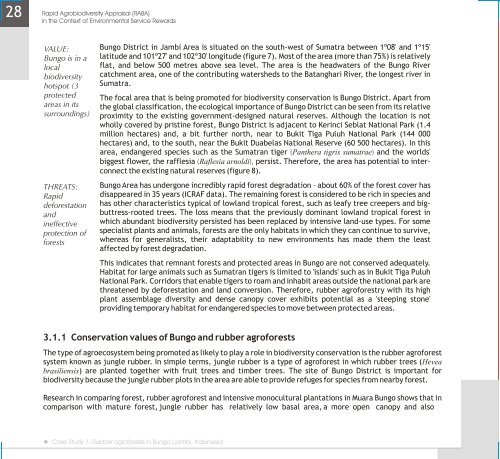Rapid Agrobiodiversity Appraisal (RABA) - Are you looking for one ...
Rapid Agrobiodiversity Appraisal (RABA) - Are you looking for one ...
Rapid Agrobiodiversity Appraisal (RABA) - Are you looking for one ...
You also want an ePaper? Increase the reach of your titles
YUMPU automatically turns print PDFs into web optimized ePapers that Google loves.
28<br />
<strong>Rapid</strong> <strong>Agrobiodiversity</strong> <strong>Appraisal</strong> (<strong>RABA</strong>)<br />
in the Context of Environmental Service Rewards<br />
VALUE:<br />
Bungo is in a<br />
local<br />
biodiversity<br />
hotspot (3<br />
protected<br />
areas in its<br />
surroundings)<br />
THREATS:<br />
<strong>Rapid</strong><br />
de<strong>for</strong>estation<br />
and<br />
ineffective<br />
protection of<br />
<strong>for</strong>ests<br />
Bungo District in Jambi <strong>Are</strong>a is situated on the south-west of Sumatra between 1º08' and 1º15'<br />
latitude and 101º27' and 102º30' longitude (figure 7). Most of the area (more than 75%) is relatively<br />
flat, and below 500 metres above sea level. The area is the headwaters of the Bungo River<br />
catchment area, <strong>one</strong> of the contributing watersheds to the Batanghari River, the longest river in<br />
Sumatra.<br />
The focal area that is being promoted <strong>for</strong> biodiversity conservation is Bungo District. Apart from<br />
the global classification, the ecological importance of Bungo District can be seen from its relative<br />
proximity to the existing government-designed natural reserves. Although the location is not<br />
wholly covered by pristine <strong>for</strong>est, Bungo District is adjacent to Kerinci Seblat National Park (1.4<br />
million hectares) and, a bit further north, near to Bukit Tiga Puluh National Park (144 000<br />
hectares) and, to the south, near the Bukit Duabelas National Reserve (60 500 hectares). In this<br />
area, endangered species such as the Sumatran tiger (Panthera tigris sumatrae) and the worlds'<br />
biggest flower, the rafflesia (Raflesia arnoldi), persist. There<strong>for</strong>e, the area has potential to interconnect<br />
the existing natural reserves (figure 8).<br />
Bungo <strong>Are</strong>a has underg<strong>one</strong> incredibly rapid <strong>for</strong>est degradation – about 60% of the <strong>for</strong>est cover has<br />
disappeared in 35 years (ICRAF data). The remaining <strong>for</strong>est is considered to be rich in species and<br />
has other characteristics typical of lowland tropical <strong>for</strong>est, such as leafy tree creepers and bigbuttress-rooted<br />
trees. The loss means that the previously dominant lowland tropical <strong>for</strong>est in<br />
which abundant biodiversity persisted has been replaced by intensive land-use types. For some<br />
specialist plants and animals, <strong>for</strong>ests are the only habitats in which they can continue to survive,<br />
whereas <strong>for</strong> generalists, their adaptability to new environments has made them the least<br />
affected by <strong>for</strong>est degradation.<br />
This indicates that remnant <strong>for</strong>ests and protected areas in Bungo are not conserved adequately.<br />
Habitat <strong>for</strong> large animals such as Sumatran tigers is limited to 'islands' such as in Bukit Tiga Puluh<br />
National Park. Corridors that enable tigers to roam and inhabit areas outside the national park are<br />
threatened by de<strong>for</strong>estation and land conversion. There<strong>for</strong>e, rubber agro<strong>for</strong>estry with its high<br />
plant assemblage diversity and dense canopy cover exhibits potential as a 'steeping st<strong>one</strong>'<br />
providing temporary habitat <strong>for</strong> endangered species to move between protected areas.<br />
3.1.1 Conservation values of Bungo and rubber agro<strong>for</strong>ests<br />
The type of agroecosystem being promoted as likely to play a role in biodiversity conservation is the rubber agro<strong>for</strong>est<br />
system known as jungle rubber. In simple terms, jungle rubber is a type of agro<strong>for</strong>est in which rubber trees (Hevea<br />
brasiliensis) are planted together with fruit trees and timber trees. The site of Bungo District is important <strong>for</strong><br />
biodiversity because the jungle rubber plots in the area are able to provide refuges <strong>for</strong> species from nearby <strong>for</strong>est.<br />
Research in comparing <strong>for</strong>est, rubber agro<strong>for</strong>est and intensive monocultural plantations in Muara Bungo shows that in<br />
comparison with mature <strong>for</strong>est, jungle rubber has relatively low basal area, a more open canopy and also<br />
Case Study 1: Rubber agro<strong>for</strong>ests in Bungo (Jambi, Ind<strong>one</strong>sia)

















![CynefinFramework final [Read-Only]](https://img.yumpu.com/19017304/1/190x135/cynefinframework-final-read-only.jpg?quality=85)